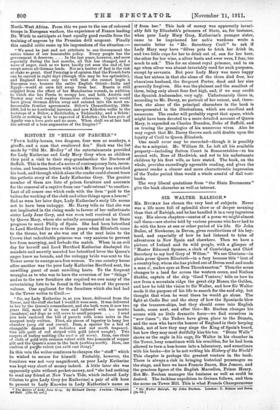giraffe, and a man that swallowed fire." Such was the
list made by " Old Mr. Medley " of the entertainments provided for Lady Katherine and Lady Mary Grey when as children they paid a visit to their step-grandmother the Duchess of Suffolk. This is the first of a series of contemporary lists, inven-
tories, and business letters with which Mr. Davey has enriched his book, and through which alone the reader could almost trace the pathetic story of the Lady Katherine Grey. The greater number of them are lists of prison furniture and accounts for the removal of a captive from one "saftS retreat" to another. Last of all comes one which ends with the item " paid to the tailors for working of the cloth and other things upon a hearse." Sad as were her later days, Lady Katherine's early life seems not to have been unhappy. Mr. Davey tells us that she was not implicated in the rising made in favour of her unfortunate sister Lady Jane Grey, and was even well received at Court by Queen Mary, whom she actually accompanied on her State progress to meet Philip of Spain. She had been betrothed to Lord Hertford for two or three years when Elizabeth came to the throne, but as she was one of the next heirs to the Crown that redoubtable princess was very anxious to prevent her from marrying, and forbade the match. When in an evil day for herself and Lord Hertford Katherine disobeyed the mandate and secretly married her betrothed lover the Queen's anger knew no bounds, and the unhappy bride was sent to the Tower never to emerge as a free woman. To one country house after another was the poor Lady Katherine Hertford sent, the unwilling guest of most unwilling hosts. To the frequent wrangles as to who was to have the reversion of her " things " and as to the new furniture she required we owe many of the entertaining lists to be found in the footnotes of the present volume. One applicant for the furniture which she had had in the Tower writes to Cecil :—
" Sir, my Lady Katherine is, as you know, delivered from the Tower, and the stuff she had I would it were seen. It was delivered to her by the Queen's comandment, and she hath worn it now two years full, most of it so torn and tattered with her monks [monkeys; and dogs as will serve to small purpose. . . . I send you here enclosed the bill of parcels with some notes in the margent truly written. First, six pieces of tapestry to hang her chamber (very old and coarse). Item, a spavier for a bed of ehangable damask (all to-broken and not worth tenpence). One silk quilt of red striped with gold (stark naught). Two carpets of turkey matting (the wool is all worn). Item, one chair of cloth of gold -with crimson velvet with two pommels of copper gilt and the Qneen's arms in the back (nothing worth). Item, one cushion of purple velvet (an owld cast thing)."
In this vein the writer continues to cheapen the " stuff " which he wished to secure for himself. Probably, however, the furniture was not very magnificent, as poor Lady Katherine was kept very short of money indeed. A little later she was apparently quite without pocket-money, and "she had nothing to send any friend at New Year's Tide, which induced Lady Clinton to give Lady Grey (or Katherine) a pair of silk hose to present to Lady Knowles in Lady Katherine's name as
• The Sisters of Lady Jan. Grey. By Richard Davey. I radon: Chapman ad Rail, [ae. ed. net.] if from her." This lack of money was apparently invari- ably felt by Elizabeth's prisoners of State, as, for instance, when poor Lady Mary Grey, Katherine's younger sister, came to be imprisoned her noMe wardress wrote a sarcastic letter to " Mr. Secrettory Cecil " to ask if Lady Mary may have "Silver pots to fetch her drink in, and two little cups for her to drink out of, one for her beer, the other for her wine, a silver basin and ewer were, I fear, too much to ask." This for an almost royal prisoner, and in an age when silver was almost invariably used for such purposes, except by servants. But poor Lady Mary was more happy than her sisters in that she alone of the three died free, her obnoxious husband, the Sergeant Porter, dead and her sins generally forgiven. She was the plainest and the smallest of them, being only about four feet high, and, if we may credit the Spanish Ambassador, very ugly. Unfortunately there is, according to Mr. Davey, no portrait of her extant, and, there- fore, she alone of the principal characters in the book is unrepresented in the illustrations, which are excellent and numerous. The reader will probably regret that space, which might have been devoted to a more detailed account of Queen Mary, is expended on Charles Brandon, Duke of Suffolk, and on tracing the genealogies of his numerous wives. Also he may regret that Mr. Davey throws such cold doubts upon the loyalty of Cecil to Queen Elizabeth.
One small error may be corrected—though it is possibly due to a misprint. Mr. William St. Lo left all his available property—including Sutton Court in Somersetshire—to his second wife, Bess of Hardwick, and not to his unfortunate children by his first wife, as here stated. The book, on the whole, provides exceedingly agreeable reading, and gives the general reader a clearer and more characteristic impression of the Tudor period than would a whole armful of dull text- books.
The very liberal quotations from " the State Documents" give the book character as well as interest.


















































 Previous page
Previous page